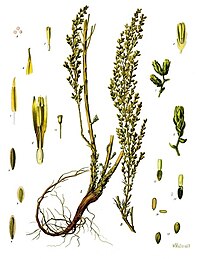
Photo from wikipedia
Xylella fastidiosa is a bacterial pathogen affecting many plant species worldwide. Recently, the subspecies pauca (Xfp) has been reported as the causal agent of a devastating disease on olive trees… Click to show full abstract
Xylella fastidiosa is a bacterial pathogen affecting many plant species worldwide. Recently, the subspecies pauca (Xfp) has been reported as the causal agent of a devastating disease on olive trees in the Salento area (Apulia region, southeastern Italy), where centenarian and millenarian plants constitute a great agronomic, economic, and landscape trait, as well as an important cultural heritage. It is, therefore, important to develop diagnostic tools able to detect the disease early, even when infected plants are still asymptomatic, to reduce the infection risk for the surrounding plants. The reference analysis is the quantitative real time-Polymerase-Chain-Reaction (qPCR) of the bacterial DNA. The aim of this work was to assess whether the analysis of hyperspectral data, using different statistical methods, was able to select with sufficient accuracy, which plants to analyze with PCR, to save time and economic resources. The study area was selected in the Municipality of Oria (Brindisi). Partial Least Square Regression (PLSR) and Canonical Discriminant Analysis (CDA) indicated that the most important bands were those related to the chlorophyll function, water, lignin content, as can also be seen from the wilting symptoms in Xfp-infected plants. The confusion matrix of CDA showed an overall accuracy of 0.67, but with a better capability to discriminate the infected plants. Finally, an unsupervised classification, using only spectral data, was able to discriminate the infected plants at a very early stage of infection. Then, in phase of testing qPCR should be performed only on the plants predicted as infected from hyperspectral data, thus, saving time and financial resources.
Journal Title: Plants
Year Published: 2021
Link to full text (if available)
Share on Social Media: Sign Up to like & get
recommendations!